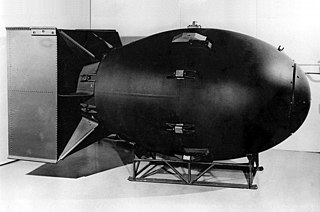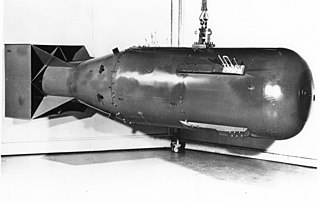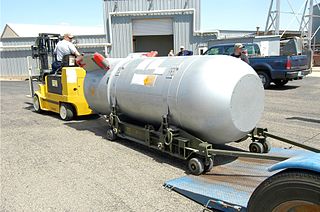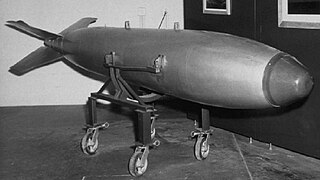This article needs additional citations for verification .(February 2022) |




The Mark 8 nuclear bomb was an American nuclear bomb, designed in the late 1940s and early 1950s, which was in service from 1952 to 1957.
This article needs additional citations for verification .(February 2022) |




The Mark 8 nuclear bomb was an American nuclear bomb, designed in the late 1940s and early 1950s, which was in service from 1952 to 1957.
The Mark 8 was a gun-type nuclear bomb, which rapidly assembles several critical masses of fissile nuclear material by firing a fissile projectile or "bullet" over and around a fissile "target", using a system which closely resembles a medium-sized cannon barrel and propellant.
The Mark 8 was an early earth-penetrating bomb (see nuclear bunker buster), intended to dig into the earth some distance prior to detonating. According to one government source, the Mark 8 could penetrate 22 feet (6.7 m) of reinforced concrete, 90 feet (27 m) of hard sand, 120 feet (37 m) of clay, or 5 inches (13 cm) of hardened armor-plate steel. [1]
The Mark 8 was 14.5 inches (37 cm) in diameter across its body and 116 to 132 inches (290 to 340 cm) long depending on submodel. It weighed 3,230 to 3,280 pounds (1,470 to 1,490 kg), and had a yield of 25-30 kilotons.
A total of 40 Mark 8 bombs were produced.
The Mark 8 was succeeded by an improved variant, the Mark 11 nuclear bomb. Both the Mark 8 and the Mark 11 could use the same fissile material "gun cores." [2]
The Mark 8 was considered as a cratering warhead for the SSM-N-8 Regulus cruise missile. This W8 variant was cancelled in 1955.
A lighter Mark 8 variant, the Mark 10 nuclear bomb, was developed as a lightweight airburst (surface target) bomb. The Mark 10 project was cancelled prior to introduction into service, replaced by the much more fissile-material-efficient Mark 12 nuclear bomb implosion design.

"Fat Man" was the type of nuclear weapon the United States detonated over the Japanese city of Nagasaki on 9 August 1945. It was the second and largest of the only two nuclear weapons ever used in warfare, the first being Little Boy, and its detonation marked the third nuclear explosion in history. The first one was built by scientists and engineers at Los Alamos Laboratory using plutonium manufactured at the Hanford Site and was dropped from the Boeing B-29 Superfortress Bockscar piloted by Major Charles Sweeney.

Little Boy was a type of atomic bomb created by the United States as part of the Manhattan Project during World War II. The name is also often used to describe the specific bomb (L-11) used in the bombing of the Japanese city of Hiroshima by the Boeing B-29 Superfortress Enola Gay on 6 August 1945, making it the first nuclear weapon used in warfare, and the second nuclear explosion in history, after the Trinity nuclear test. It exploded with an energy of approximately 15 kilotons of TNT (63 TJ) and had an explosion radius of approximately 1.3 kilometres (0.81 mi) which caused widespread death across the city. It was a gun-type fission weapon which used uranium that had been enriched in the isotope uranium-235 to power its explosive reaction.

Nuclear weapons design are physical, chemical, and engineering arrangements that cause the physics package of a nuclear weapon to detonate. There are three existing basic design types:

Yellow Sun was the first British operational high-yield strategic nuclear weapon warhead. The name refers only to the outer casing; the warhead was known as "Green Grass" in Yellow Sun Mk.1 and "Red Snow" in Yellow Sun Mk.2.

The W25 was a small nuclear warhead that was developed by the Los Alamos Scientific Laboratory for air-defense use. It was a fission device with a nominal yield of 1.7 kt.

The Mk/B53 was a high-yield bunker buster thermonuclear weapon developed by the United States during the Cold War. Deployed on Strategic Air Command bombers, the B53, with a yield of 9 megatons, was the most powerful weapon in the U.S. nuclear arsenal after the last B41 nuclear bombs were retired in 1976.

Gun-type fission weapons are fission-based nuclear weapons whose design assembles their fissile material into a supercritical mass by the use of the "gun" method: shooting one piece of sub-critical material into another. Although this is sometimes pictured as two sub-critical hemispheres driven together to make a supercritical sphere, typically a hollow projectile is shot onto a spike, which fills the hole in its center. Its name is a reference to the fact that it is shooting the material through an artillery barrel as if it were a projectile.

The Mark-12 nuclear bomb was a lightweight nuclear bomb designed and manufactured by the United States which was built starting in 1954 and which saw service from then until 1962.

The Mark 5 nuclear bomb and W5 nuclear warhead were a common core American nuclear weapon design, designed in the early 1950s and which saw service from 1952 to 1963.

The Mark 4 nuclear bomb was an American implosion-type nuclear bomb based on the earlier Mark 3 Fat Man design, used in the Trinity test and the bombing of Nagasaki. With the Mark 3 needing each individual component to be hand-assembled by only highly trained technicians under closely controlled conditions, the purpose of the Mark 4 was to produce an atomic weapon as a practical piece of ordnance. The Mark 4 Mod 0 entered the stockpile starting March 19, 1949 and was in use until 1953. With over 500 units procured, the Mark 4 was the first mass-produced nuclear weapon.

The Mark 39 nuclear bomb and W39 nuclear warhead were versions of an American thermonuclear weapon, which were in service from 1957 to 1966.

The Mark 18 nuclear bomb, also known as the SOB or Super Oralloy Bomb, was an American nuclear bomb design which was the highest yield fission bomb produced by the US. The Mark 18 had a design yield of 500 kilotons. Nuclear weapon designer Ted Taylor was the lead designer for the Mark 18.

The Mark 6 nuclear bomb was an American nuclear bomb based on the earlier Mark 4 nuclear bomb and its predecessor, the Mark 3 Fat Man nuclear bomb design.
The Mark 10 nuclear bomb was a proposed American nuclear bomb based on the earlier Mark 8 nuclear bomb design. The Mark 10, like the Mark 8, is a Gun-type nuclear weapon, which rapidly assembles several critical masses of fissile nuclear material by firing a fissile projectile or "bullet" over a fissile "target", using a system which closely resembles a medium-sized cannon barrel and propellant.
The B61 Family is a series of nuclear weapons based on the B61 nuclear bomb.

The W33 was an American nuclear artillery shell designed for use in the 8-inch (203 mm) M110 howitzer and M115 howitzer.

The Mark 11 nuclear bomb was an American nuclear bomb developed from the earlier Mark 8 nuclear bomb in the mid-1950s. Like the Mark 8, the Mark 11 was an earth-penetrating weapon, also known as a nuclear bunker buster bomb.

The Mark 15 nuclear bomb, or Mk-15, was a 1950s American thermonuclear bomb, the first relatively lightweight thermonuclear bomb created by the United States.
The Mark 13 nuclear bomb and its variant, the W-13 nuclear warhead for Redstone BM and Snark CM, were experimental nuclear weapons developed by the United States from 1951 to 1954. The Mark 13 design was based on the earlier Mark 6 nuclear bomb design, which was in turn based on the Mark 4 nuclear bomb and the Mark 3 nuclear bomb used at the end of World War II.